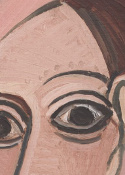Scarified Skin and Simian Symptoms: Experimental Medicine and Picasso’s Les Demoiselles d’Avignon
by Kathleen Pierce

This article argues for deep formal, material, morphological, and philosophical connections between a series of experimental syphilis studies conducted on simian research subjects at the Institut Pasteur by Émile Roux and Élie Metchnikoff and Pablo Picasso’s Les Demoiselles d’Avignon (1907). It positions three caricatures of the Institut Pasteur studies published in the illustrated anarchist weekly L’Assiette au beurre (1905–11), which alternately depict Roux and Metchnikoff’s monkeys as prostitutes or as Moroccans enduring the brutality of colonial medicine, at the crux of this relationship. This study contends that these images’ pictorial blending of human and animal bodies illuminates shared logics of exploitation and professionalization structuring research in experimental medicine, colonial medicine, and venereology. The invocation of these shared logics by both L’Assiette au beurre and Picasso evince the ways medical discourses of raced, gendered, diseased, and animal bodies permeated spheres of knowledge and visual culture production.